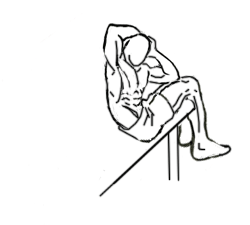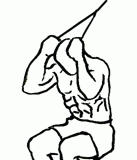Last Updated on September 30, 2022
The decline oblique crunch is an advanced core exercise designed to isolate and target the oblique muscles—the muscles that run along the sides of your abdomen. These muscles play a crucial role in stabilizing your core, improving rotational strength, and enhancing overall abdominal definition. By performing this exercise on a decline bench, you increase the intensity and difficulty, making it an excellent addition to any core-strengthening routine.
This exercise engages not only the obliques but also the rectus abdominis (the “six-pack” muscles) and other stabilizing muscles in your core. Whether you’re an athlete looking to improve rotational power or simply aiming to sculpt your midsection, the decline oblique crunch is a must-have in your fitness arsenal.
In this comprehensive guide, we’ll explore the benefits, proper technique, common mistakes, and how to incorporate the decline oblique crunch into your workout for optimal results.
What Is a Decline Oblique Crunch?
The decline oblique crunch is a variation of the traditional crunch performed on a decline bench. This version specifically targets the oblique muscles by incorporating a twisting motion as you raise your shoulders and chest. The decline angle increases the resistance, forcing your oblique muscles to work harder than they would in a standard crunch.
The twisting motion of this exercise ensures that the obliques are isolated, helping to strengthen and define these important core muscles. Oblique exercises like the decline oblique crunch are crucial for building a well-rounded core, as they contribute to better balance, stability, and overall athletic performance.
Muscles Worked During Decline Oblique Crunch
While the decline oblique crunch primarily targets the obliques, it also engages other important muscles in the core and upper body. Here’s a breakdown of the muscles worked:
- Obliques: The primary muscle group targeted during this exercise, the obliques are responsible for twisting and rotating your torso. This movement helps develop side definition and core stability.
- Rectus Abdominis (Six-Pack Muscles): The rectus abdominis muscles assist during the crunching motion, particularly in stabilizing your torso as you twist to one side.
- Hip Flexors: The hip flexors help stabilize your lower body as your upper body rises from the decline position. These muscles are particularly engaged when you keep your feet anchored under the pads of the bench.
- Core Stabilizers: Other muscles in the core, such as the transverse abdominis and lower back muscles, play a supporting role in stabilizing your body throughout the movement.
Benefits of the Decline Oblique Crunch
The decline oblique crunch offers a wide range of benefits that can improve both your aesthetic goals and functional strength. Here are some of the key advantages:
- Enhanced Core Definition: By isolating the oblique muscles, this exercise helps develop a more defined and sculpted midsection. It also engages the lower and upper abs, contributing to an overall leaner appearance.
- Improved Rotational Strength: The twisting motion in the decline oblique crunch helps improve rotational strength, which is vital for sports and activities that involve twisting motions (e.g., tennis, golf, or baseball).
- Better Balance and Stability: Strengthening the obliques and other core muscles can improve your balance and stability, reducing the risk of injury in everyday movements and during workouts.
- Increased Abdominal Strength: The decline position adds extra resistance, making this exercise more challenging than a standard crunch. This increased difficulty helps build stronger abs and obliques over time.
- Functional Fitness: Oblique exercises like this one are essential for maintaining a strong and functional core, which is crucial for good posture, daily movements, and overall fitness performance.
Proper Technique for Decline Oblique Crunch
Performing the decline oblique crunch with proper form is essential to get the most out of the exercise and avoid injury. Follow these step-by-step instructions to perform the exercise correctly:
- Set up the decline bench: Start by adjusting the bench to a decline angle, typically between 15 and 30 degrees. The steeper the angle, the more challenging the exercise will be. Sit on the bench with your feet securely placed under the footpads.
- Position your hands: Lie back on the bench with your head lower than your feet. Place your hands either across your chest or on the sides of your head, being careful not to pull on your neck. Your arms should be relaxed and not contribute to the movement.
- Engage your core: Before starting the movement, engage your core muscles by pulling your belly button toward your spine. This will help protect your lower back and maximize core activation.
- Raise your shoulders: Slowly raise your shoulders and chest off the bench, keeping your lower back in contact with the bench. As you rise, twist your torso to the right, bringing your left elbow toward your right knee. Focus on using your obliques to perform the twist rather than your arms or neck.
- Pause and squeeze: At the top of the movement, pause briefly and squeeze your oblique muscles to maximize engagement.
- Return to the starting position: Slowly lower your shoulders and chest back to the starting position, ensuring that you maintain control throughout the descent.
- Repeat on the other side: After returning to the starting position, repeat the movement, this time bringing your right elbow toward your left knee. Continue alternating sides for the desired number of repetitions.
- Repeat: Aim for 3 to 4 sets of 10 to 15 reps per side, depending on your fitness level and goals.
Common Mistakes to Avoid
To ensure that you’re performing the decline oblique crunch effectively and safely, it’s important to avoid these common mistakes:
- Pulling on the Neck: One of the most common mistakes is pulling on the neck with your hands as you crunch. This can strain your neck and take the focus away from your core. Keep your hands light and focus on your abs doing the work.
- Using Momentum: Avoid using momentum to lift your torso off the bench. Instead, focus on slow, controlled movements that engage your obliques and core muscles. Momentum reduces the effectiveness of the exercise and increases the risk of injury.
- Flaring the Elbows: If your elbows flare out too far, it can shift the focus away from your core and onto your shoulders. Keep your elbows slightly bent and close to your body throughout the movement.
- Not Twisting Enough: To fully engage the obliques, it’s important to include a proper twisting motion. Simply lifting straight up like a regular crunch won’t isolate the obliques effectively. Make sure you’re rotating your torso with each rep.
- Arching the Lower Back: Make sure your lower back remains in contact with the bench throughout the movement. Arching your back can place unnecessary stress on your spine and reduce the effectiveness of the exercise.
Variations of the Decline Oblique Crunch
Once you’ve mastered the basic decline oblique crunch, you can try these variations to keep your workouts challenging and target your oblique muscles from different angles:
- Weighted Decline Oblique Crunch: Hold a weight plate or dumbbell across your chest or near your shoulders to increase resistance. This variation adds intensity and helps further develop your obliques.
- Cable Decline Oblique Crunch: Use a cable machine attached to one side of the bench to add resistance. This variation increases tension on your obliques throughout the movement, enhancing muscle activation.
- Medicine Ball Decline Oblique Crunch: Hold a medicine ball in your hands and perform the same twisting motion. The added weight will challenge your obliques and core even more.
- Leg Raise with Oblique Twist: Combine a decline leg raise with an oblique twist at the top of the movement. This variation works both your lower abs and obliques, giving you a more comprehensive core workout.
- Decline Oblique Crunch to Sit-Up: Instead of stopping at a partial crunch, continue the movement into a full sit-up while twisting your torso. This advanced variation increases the difficulty and engages more core muscles.
How to Incorporate Decline Oblique Crunch into Your Workout Routine
The decline oblique crunch is a versatile exercise that can be included in various workout programs, especially those focused on core strength and abdominal definition. Here’s how to effectively incorporate it into your routine:
- Frequency: Aim to perform decline oblique crunches 2 to 3 times per week as part of your core or abdominal training routine.
- Sets and Reps: For muscle growth and strength, perform 3 to 4 sets of 10 to 15 reps per side. If you’re focusing on endurance, opt for higher reps with lighter weight or bodyweight only.
- Combine with Other Core Exercises: Pair decline oblique crunches with other core exercises like planks, hanging leg raises, or Russian twists for a complete core workout that targets all areas of the abs.
- Rest Between Sets: Allow 30 to 60 seconds of rest between sets to ensure proper recovery while maintaining intensity.
Sample Core Workout with Decline Oblique Crunch
To help you incorporate the decline oblique crunch into a balanced core workout, here’s a sample routine:
- Warm-Up (5-10 minutes)
- Light cardio (e.g., jogging or jumping jacks) and dynamic stretching focusing on the core.
- Workout:
- Decline Oblique Crunch – 4 sets of 12-15 reps per side
- Plank with Oblique Twist – 3 sets of 30-45 seconds per side
- Russian Twists (with or without weight) – 3 sets of 20-30 reps per side
- Hanging Leg Raises – 4 sets of 10-12 reps
- Bicycle Crunches – 3 sets of 20-30 reps per side
- Side Plank (with reach-throughs) – 3 sets of 30-45 seconds per side
- Cooldown (5-10 minutes)
- Static stretching, focusing on the core and obliques. Incorporate stretches such as the cobra pose, lying spinal twist, and side bends to help lengthen and relax your abdominal muscles.
Is the Decline Oblique Crunch Right for You?
The decline oblique crunch is an effective exercise for anyone looking to strengthen and define their obliques, as well as improve overall core stability and rotational strength. Whether you’re an athlete, a fitness enthusiast, or simply aiming for better abs, this exercise is a great addition to your routine.
For beginners, it’s important to start with bodyweight only and focus on mastering the technique. As you become more comfortable with the movement, you can gradually increase the intensity by adding weight or incorporating more advanced variations. However, if you have lower back or neck issues, make sure to consult with a fitness professional to ensure this exercise is safe for you.
Final Tips for Success
- Focus on Form: Proper form is crucial to effectively target the obliques and prevent injury. Keep your elbows tucked, avoid pulling on your neck, and focus on twisting your torso rather than using momentum.
- Breathe Correctly: Inhale as you lower your torso and exhale as you twist and crunch. Proper breathing helps you stay controlled and focused, ensuring your core remains engaged throughout the movement.
- Stay Consistent: Like any other muscle group, the obliques need consistent training to see progress. Incorporate decline oblique crunches into your regular core workouts to develop stronger, more defined abs.
- Gradually Increase the Challenge: Once you’ve mastered the basic movement, consider adding weight or trying advanced variations to keep your workouts challenging and your muscles growing.
- Incorporate Core Variations: The decline oblique crunch works best when combined with other core exercises that target different areas of your abs. Mix it up with planks, leg raises, and other rotational movements to ensure balanced core development.
The decline oblique crunch is a powerful exercise that isolates the oblique muscles, helping you achieve a more defined and balanced core. By incorporating this movement into your routine, you’ll not only strengthen your side abs but also improve your overall core stability and rotational strength—essential for athletic performance and functional fitness.
Whether your goal is to build visible abs, improve balance, or enhance your athletic abilities, the decline oblique crunch offers a challenging and effective way to target your obliques and take your core training to the next level. With proper technique, consistency, and progressive overload, you’ll start to see results in no time.








